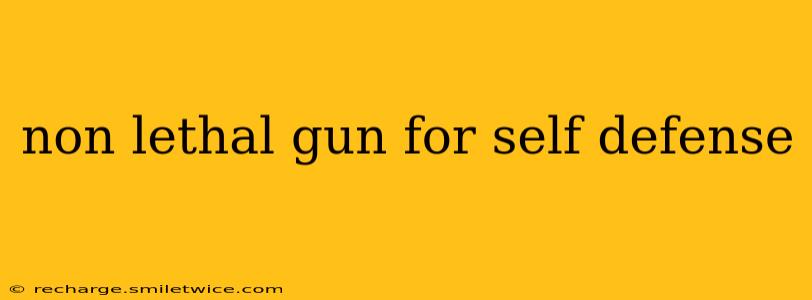Choosing the right self-defense tool is a crucial decision, demanding careful consideration of legality, effectiveness, and personal responsibility. Non-lethal self-defense options offer a way to protect yourself without causing potentially fatal injuries. While no self-defense tool guarantees complete safety, understanding the different types of non-lethal guns can help you make an informed choice. This guide explores various options, their advantages and disadvantages, and crucial considerations before purchasing any self-defense weapon.
What are Non-Lethal Guns?
Non-lethal guns, also known as less-lethal weapons, are designed to incapacitate an attacker without causing serious or permanent harm. They typically use projectiles like rubber bullets, pepper balls, or beanbags, or deploy other deterrents such as tasers or stun guns. It's crucial to understand that while "non-lethal" implies a lower risk of death, these weapons can still cause injury and should only be used as a last resort in self-defense situations.
Types of Non-Lethal Guns
Several types of non-lethal guns are available, each with its own set of pros and cons:
1. Pepper Ball Guns:
These guns fire small projectiles filled with oleoresin capsicum (OC), the active ingredient in pepper spray. The impact and the OC cause temporary incapacitation through intense burning and irritation to the eyes, skin, and respiratory system.
- Advantages: Relatively high accuracy compared to other less-lethal options. Can be effective at a distance.
- Disadvantages: Requires precise aiming. Environmental conditions (wind) can affect accuracy. Can still cause serious injury in some cases.
2. Rubber Bullet Guns:
These firearms launch rubber bullets designed to incapacitate through blunt force trauma. The impact can cause significant pain and bruising.
- Advantages: Can stop a threat from a distance.
- Disadvantages: Potential for serious injury or even death, especially at close range or with multiple shots. Legality varies significantly by location.
3. Bean Bag Guns:
Similar to rubber bullet guns, bean bag guns shoot fabric bags filled with small lead shot or other materials. These bags cause blunt force trauma but generally are less likely to cause penetrating injuries compared to rubber bullets.
- Advantages: Less likely to cause penetrating injuries than rubber bullets. Relatively less lethal than other options.
- Disadvantages: Can still cause serious injuries, particularly to the head or neck. Effectiveness decreases at longer ranges.
4. Tasers (Stun Guns):
While not strictly a "gun," tasers are frequently considered in the same category of self-defense weapons. These devices use electrified probes to deliver a high-voltage, low-amperage shock, temporarily incapacitating the target with muscle spasms and pain.
- Advantages: Relatively short-range but very effective at stopping an immediate threat.
- Disadvantages: Requires close proximity to the target. Ineffective against individuals under the influence of drugs or alcohol, or those with certain medical conditions. Legality varies.
What are the Legal Considerations of Owning a Non-Lethal Self-Defense Gun?
Legal restrictions regarding the ownership and use of non-lethal self-defense weapons vary significantly by location. Laws can differ between states, provinces, or even cities. Before purchasing any non-lethal self-defense weapon, it's crucial to research the specific laws in your jurisdiction regarding its possession, use, and the circumstances under which it's legally permissible to deploy it.
Are Non-Lethal Guns Effective for Self-Defense?
The effectiveness of a non-lethal self-defense gun depends heavily on several factors, including:
- The attacker's state of mind: Someone under the influence of drugs or alcohol, or highly agitated, may not be easily incapacitated.
- The distance between you and the attacker: Many non-lethal weapons have a limited effective range.
- Your level of training and proficiency: Knowing how to properly aim and use the weapon is crucial.
- The specific type of weapon: Different weapons have different levels of effectiveness.
What are the Risks Associated with Non-Lethal Self-Defense Weapons?
While designed to be less lethal, non-lethal weapons still carry risks:
- Accidental injury: Misuse or accidental discharge can result in injuries to yourself or bystanders.
- Escalation of violence: The use of a weapon can escalate a situation, leading to more serious violence.
- Legal consequences: Even when used in self-defense, the use of a weapon can lead to legal consequences if the situation is not properly justified.
Choosing the Right Non-Lethal Gun for Self-Defense
The best non-lethal gun for self-defense depends on your individual circumstances, physical abilities, and the specific threats you face. Consider factors like your level of training, your physical limitations, and the legal requirements in your area. It is strongly recommended to take a self-defense course that includes training in the safe and effective use of non-lethal weapons.
Remember, responsible gun ownership is paramount. Proper training, understanding of legal limitations, and awareness of potential risks are crucial aspects of utilizing non-lethal self-defense tools effectively and safely. Always prioritize de-escalation techniques before resorting to any form of self-defense. Consulting with law enforcement or a self-defense expert is recommended before making a decision.
